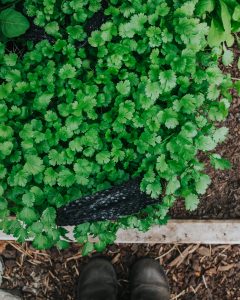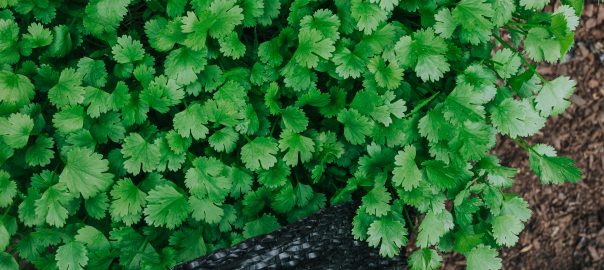Grow Me Now!
July
Coriander for the Culinary!
It must surely rank among the most pungent of herbs, and there’s no doubt that you either love it or loathe it. That’s because, genetically, coriander divides the population in two, with some experiencing it’s taste as ‘soapy’ while others find it delicious.In India, coriander is known ‘The King of Herbs,’ and is used throughout the nation. In the south, the population uses its fresh, green foliage, in a variety of dishes. In the north, it’s the dried, ground coriander seed that is sought after for use in rich, spicy sauces. Coriander is a value-for space herb in the tunnelhouse as its root can also be used in cooking. Coriander prefers to grow into cooler weather – in conditions that are too warm, it quickly runs to seed. It makes for a perfect winter crop in the greenhouse, in cooler regions, or in a crop tunnel in warmer climes.

Source
Coriander seed is not difficult to locate on the garden centre shelves, however it is best sown thickly, and there is usually only a scattering of seed in a packet. Better by far, is to purchase food-grade seed in bulk, for a fraction of the price. This can be found in the likes of Bin Inn or Asian food suppliers. Once you have coriander growing in your own garden or greenhouse, simply let a few plants bolt, and collect the seeds when they are dry. Left to its own devices, coriander readily self seeds, in which case you may never need to sow it again!
Ground work
Coriander is all leaf, which makes it a nitrogen-hungry herb. Give it what it requires in the form of plenty of sterilised manure, and lashings of compost. If you don’t have access to organic ingredients, dig in a scattering of high-nitrogen fertilizer. There is no need to add lime unless your tunnelhouse soil is significantly acid, as coriander is tolerant of a range of pH levels. The seed does not like to struggle through the ground, so make the soil as fine as you can, and keep it free draining. In winter conditions, even in the tunnelhouse, coriander appreciates sun, so don’t hide it in the shade of climbers or tall, bulky brassicas, or silverbeet.
Sowing
If you enjoy coriander, you will never have enough of it, so sow plenty, and freeze it for summer, when it is too warm for it to grow without running to seed. If you are growing it to freeze, sow the seed thickly in 10cm wide rows. If you want to pick just a few leaves daily, sow seed 2-3cm apart. However you do it, bear in mind that coriander seeds are ‘conglomerate,’ as are the seeds of beetroot and silverbeet. Conglomerate seeds produce more than one plant from a seed, so take this into account when spacing. Cover the seed with twice its depth of soil, water deeply, and place a non-treated board over the row to lock in the damp until germination occurs. After that, water frequently. Note: coriander seed has a hard outer coating which means it is slow to germinate (taking 2-3 weeks in tunnelhouse conditions). Consider soaking the seed in warm water for an hour prior to sowing to hurry along germination (it floats, so you will need to place a saucer over it to keep it submerged).
Maintenance
Coriander doesn’t enjoy competition, so keep the bed well weeded. Visit the tunnelhouse after dark, with a torch, to pick off any slugs and snails that are about. Coriander can attract fungal disease, but this can usually be managed by keeping the tunnelhouse well-ventilated. Aid air movement around the young plants by thinning as you harvest.
Tips
Although you may find coriander plants for sale in gardening centres, it is best grown from seed due to its tendency to bolt when transplanted.
Coriander is slow to germinate, taking up to 14 to 21 days, depending on conditions. It can be helpful to mark the row by sowing a few fast-germinating radish seed with your coriander.
Avoid coriander bolting by keeping the ground damp.
In dry conditions, white fly will quickly colonise the plants. Don’t let the ground dry out.
To get the best value from the plants, harvest the leaves before a central stem starts growing. Once this happens, the leaves become spindly, and the plants are all ‘stalk.’
Coriander freezes ‘like a dream.’ Chop it finely and free-flow it in snap lock bags. Use it frozen (don’t allow it to thaw before adding it to dishes).
